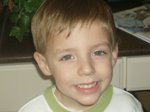I was so excited to read this book because I heard that it is a great teaching novel. I have heard many middle school teachers refer to using it for various things. I was intriqued by the size and cover of Seedfolks. It was much smaller than I thought it would be, it was was actually similar in size to Van Gogh Cafe' by Cynthia Rylant. Though I had heard that this was a good book, I had heard nothing of what it was about.
Soon into the book it reminded me of the book Flipped that I blogged on previously. Seedfolks tells the story of many different people and how this random plot of land affected their lives. Each chapter was of course from a different point of view much like Flipped. The difference was that Flipped told a story over time and focused on two main characters and Sedfolks was a short specific time period and many characters were featured. Each chapter was about a different person and that person was not featured again.
The characters in Seedfolks all lived in the same general neighborhood and each had a hardship of sorts. Kim, the first person introduced in seedfolks, is the first person to use the land. Kim never met her father who died before her birth. She worries that he will not know her when he checks on the family from heaven. Since he was an avid farmer she decides to grow lima beans in the empty lot to connect to him. This is how it all got started. Another person sees her and wonders what she is doing, it must be no good. The concerend neighbor goes to dig up the expected the drugs and discovers the lima beans. The cycle continues. As time goes by more and more people decided to plant a small garden in the lot.
Each person is using the lot to fill a need or gain something. Some need food, some desire attention from a special person, others need to feel empowered and important.
I liked the book but at this point it is not a favorite for me. I will definitely file away for a special occassion.
Wednesday, March 21, 2007
Subscribe to:
Post Comments (Atom)


4 comments:
I was drawn by the unique way in which the author drew together so many strangers to share a common bond that none seemed to appreciate near as much as the reader. It was gratifying to see the healing that was occurring in such desolate living conditions. I'd like to see a students interpret this book into a play. That may be a way to celebrate multiculturalism.
Since a teacher who works with you (& someone I greatly admire as a teacher) uses this novel with her 8th graders, I would love to hear how she uses it. Perhaps, if you get a chance, you could speak with her? Does she teach it in small groups? Individual? Whole class? How do her kids respond? I'd love to know more from someone who has applied it in class.
Every time a newer character would mention something about a character that I had gotten to know as a reader previously, I found myself going back and researching and asking questions like, "who's corn was being smashed by trashy tires", "who was the man in the rocking chair waving to Florence? (was it Mr. Myles - the stroke victim?), "Did Maricella have her baby yet"? I wanted to know how these characters were doing and tell them hello. Fleischman certainly drew me into the lives of these seemingly different characters!
I did enjoy this book. Like you though, it is not one of my favorites. I was impressed by the authors ability to keep us connected through so many characters and plot lines. However, I prefer books that give us a more intimate portrait of a few characters than a snapshot of many.
Post a Comment